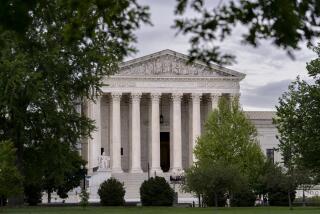Supreme Court is religiously inconsistent
- Share via
The Supreme Court was right to hand down (though not on stone tablets) a ruling against a religious group that demanded that its precepts share space in a public park with the Ten Commandments. But the controversy never would have arisen if the court had adopted a consistent attitude toward religious displays on public property. A California case offers the justices an opportunity to clear away the confusion.
Last week, the court unanimously ruled that the 1st Amendment’s free-speech protections didn’t require Pleasant Grove City, Utah, to display tablets bearing the “Seven Aphorisms” of the Summum faith, among them “Nothing rests; everything moves; everything vibrates.” Adherents believe that the aphorisms were provided by God to Moses on Mt. Sinai, just as the Ten Commandments were.
Writing for the court, Justice Samuel A. Alito Jr. said the park wasn’t a public forum. Rather, the Ten Commandments and other monuments in the park were “government speech,” which needn’t be balanced against other points of view. The principle is a sound one. No one would suggest that critics of President Obama’s stimulus plan have a 1st Amendment right to commandeer White House printers to run off fliers stating their objections.
The problem is that the Ten Commandments convey an essentially religious message, albeit an older and more familiar one than the Seven Aphorisms. Alito was emphatic that the decision didn’t undermine language in the 1st Amendment prohibiting a government “establishment” of religion. Still, the practical effect of the ruling is that a text sacred to Jews and Christians is displayed in a public park, but not the teachings of a minority religion.
In a pair of 5-4 decisions, the court in 2005 struck down the posting of the Ten Commandments in courthouses in Kentucky but upheld a display on the grounds of the Texas Capitol. Then-Chief Justice William H. Rehnquist concluded, unconvincingly, that the latter display served the secular purpose of acknowledging “the role played by the Ten Commandments in our nation’s heritage.” The decision in the Texas case encouraged some religious activists to believe that the court was stealthily lowering the wall separating church and state. They may also take comfort from last week’s decision. The way to dispel that impression is for the court to make clear that permissible “government speech” doesn’t include endorsing a particular religion.
The court will have an opportunity to do that when it rules, probably next year, on a challenge to the constitutionality of just such a message: an eight-foot-tall cross in the Mojave National Preserve commemorating war dead. Californians who insist that such a display is innocuous should ask themselves how they would feel if the cross were replaced by the Seven Aphorisms.
More to Read
A cure for the common opinion
Get thought-provoking perspectives with our weekly newsletter.
You may occasionally receive promotional content from the Los Angeles Times.









